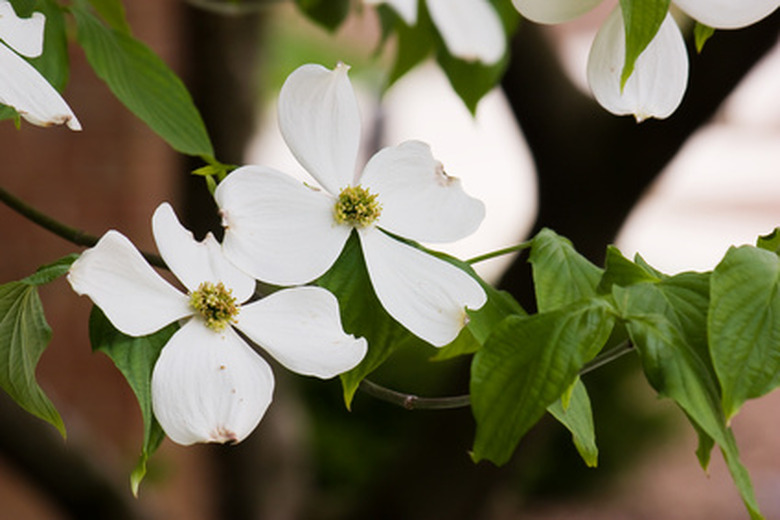Advice On Growing Dogwood Trees In Piedmont, North Carolina
One of the American Southeast's most beautiful native trees, there are challenges to growing flowering dogwoods (Cornus florida) in the Piedmont of North Carolina, the region from the Blue Ridge Mountains eastward to the Fall Line on the Atlantic Coastal Plain. As long as the soil is acidic and moist, the flowering dogwood will grow well in partial shade. Consider growing the kousa dogwood tree in full sun garden settings.
Light Exposure
While many choose to plant a flowering dogwood in full sun, receiving direct sunlight for more than eight to 10 hours daily, it is best to situate it with less intense light. This species is native to the understory of the eastern woodlands, where it naturally gets dappled sunlight under the tall, open branches of pines, tulip poplars and beeches. This partial shade light exposure allows about two to six hours of direct sun to reach the foliage, always in shifting amounts across the day. Too much shade leads to fungal diseases on the leaves. Too much intense sun burns leaf edges and increases need for soil moisture.
- One of the American Southeast's most beautiful native trees, there are challenges to growing flowering dogwoods (Cornus florida) in the Piedmont of North Carolina, the region from the Blue Ridge Mountains eastward to the Fall Line on the Atlantic Coastal Plain.
- This partial shade light exposure allows about two to six hours of direct sun to reach the foliage, always in shifting amounts across the day.
Soil
The soil for a flowering dogwood must be moist and acidic for the tree to prosper. The tree does not tolerate soils that flood or are soggy after a simple rainstorm, so there must be timely drainage of water, too. Plant the dogwood in a clay, loam or sandy soil that is rich in organic matter, and mulch the root zone around the tree to keep the soil cool in summer as well as retain moisture and add nutrients.
Diseases/Pests
Two diseases are of particular concern for the flowering dogwood in North Carolina. The first is anthracnose, a fungal disease that forms leaf spots and cankers on the twigs and trunks. This fungus kills a dogwood tree by disrupting the flow of water and sugars in the vascular tissues. The second disease or ailment is powdery mildew, which is a white powdery covering on leaves. If the spring and summer are particularly rainy and humid, powdery mildew can mask leaves and reduce photosynthesis, and over time can weaken and kill the tree.
- The soil for a flowering dogwood must be moist and acidic for the tree to prosper.
- If the spring and summer are particularly rainy and humid, powdery mildew can mask leaves and reduce photosynthesis, and over time can weaken and kill the tree.
An insect pest of note is the dogwood borer, which tends to lay its eggs on weakened trees that have been inflected first by anthracnose or powdery mildew. The larva bore into the tree's bark and burrow into wood, drying the tree.
Healthy trees are less susceptible to these threats. If there is good air circulation, appropriate sunlight and moist, fertile soil to the dogwood, chances are these problems will not occur.
Improved Selections
Modern plant breeding has given rise to new cultivars, cultivated varieties, of flowering dogwood trees that have better resilience to different growing conditions and diseases and pests. Although any dogwood growing in less than perfect conditions can still struggle and succumb to threats, the Stellar Series hybrid collection of dogwoods may be the best choice in your garden. At your nursery, look for selections named Aurora, Celestial and Stellar Pink, among other registered-trademark names.
- An insect pest of note is the dogwood borer, which tends to lay its eggs on weakened trees that have been inflected first by anthracnose or powdery mildew.
- Modern plant breeding has given rise to new cultivars, cultivated varieties, of flowering dogwood trees that have better resilience to different growing conditions and diseases and pests.
Alternative Dogwood Tree
If the native flowering dogwood failed in your landscape because of disease or old age, perhaps a kousa dogwood (Cornus kousa) would be of interest to you. Not affected as severely by anthracnose and resilient to powdery mildew since it grows best in sunnier locations, the kousa dogwood also differs by flowering in late spring when the leafs are present.
References
- North Carolina State University: Cornus florida
- "Month-by-Month Gardening in the Carolinas"; Bob Polomski; 2000
- "Rodale's Garden Insect, Disease & Weed Identification Guide"; Miranda Smith and Anna Carr; 1988
